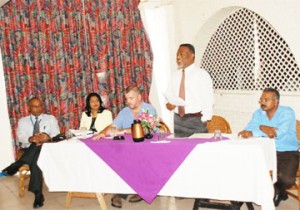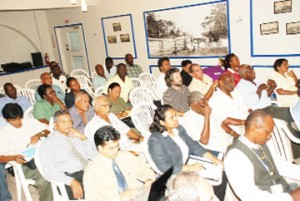-as long as financing tied up
The long-awaited Amaila Falls Hydro Electric Power (AFHEP) project is now expected to get underway during the first quarter next year once there is financial closure with a number of private and public sector partners.
Once the US$400-US$500 million Kuribrong River project gets underway it is expected to be completed three years later, President of Synergy Holdings Makeshwar Fip Motilall told a well-attended meeting, which included Prime Minister Sam Hinds, at the Hotel Tower yesterday with local contractors and other stakeholders interested in the project.
Phase I will involve the installation of 154 megawatt capacity; the installation of 278 km of double-circuit 230KV lines; and the construction of 85 kilometres of new access roads.
Hydro-electricity has been a long-promised power option since the 1960s but is yet to materialize. The project will involve the construction of two dams built on top of an escarpment and the construction of a tunnel to convey water to the powerhouse.
- Prime Minister Sam Hinds (standing) making brief remarks at the Amaila Fall Hydro Electric Power project meeting. From left are GPL General Manager Bharrat Dindyal, legal advisor attached to NICIL Marcia Nadir-Sharma, Christopher Kelly of Sithe Global Power, and President of Synergy Holdings Inc Makeshwar Fip Motilall. (Photo by Jules Gibson)
In Phase II of the project, the power capacity would be expanded to 410 megawatts and in Phase III, it would be further upgraded to 1060 megawatts. These two phases would most likely require the export of power to Brazil.
At present the bids for engineering, procurement and construction are out to tender. Motilall said that there were five serious bidders, three of whom have asked for an extension to the September deadline for submission of their bids. The deadline has now been pushed back to October 30, 2008.
Asked where financing for the project which Synergy has had in the pipeline for over a decade is coming from, Motilall said that there is an equity financing contribution of about 25% or 30% of the cost for which Sithe Global Power has committed 100%. Sithe Global (New York started due diligence on AFHEP and Guyana in 2006 and it has committed all the equity required to build the project after completing the technical and commercial due diligence. Sithe Global is a subsidiary of Blackstone – the largest private equity fund in USA.
Christopher Kelly of Sithe Global, who was also present at the meeting said that the project was basically a BOOT (build, own, operate and transfer) project meaning it would be constructed essentially with private funding and twenty years after going into commercial operation it would become the property of the state. By then he said that the cost of producing power “would be operating costs since the loans secured privately would have been paid back.”
The lender/lenders, Motilall said, will bring to the project 70% to 75% of the cost and lending will come basically from the private sector arm of the Inter-American Development Band and the private sector arm of the World Bank, which are both based in Washington DC. He said, too, that due to the magnitude of the project there would be several aspects and international contractors/subcontractors, for example from China “who, if they want to participate in the project would have to bring financing from their investment banks.” He noted that in the same way the IDB would provide funding to the Americas, there are other banks in regional blocks such as China that provide financing for such projects as well.
Open Book
According to Motilall, Synergy and its partners have agreed to an ‘Open Book’ approach to financing the project and this will mean that all bids will be jointly evaluated to ensure the best deal for both the government and Synergy holdings; the government would look at the costs and could offer financing options, including having the option to provide financing as well. This, he said, would allow for a much faster development schedule as all agreements for the various components of the project do not have to be agreed on to start project.
Synergy and the Guyana government agreed on public/private sector funding to finance the AFHEP, even though privately developed hydro projects are unusual. Motilall said that the project is even more challenging because the site is 278 km from the main load centres of the Berbice Demerara Inter-connected System (BDIS). Transmission lines are part of this project and it will include sub-stations at Linden and Sophia.
Social impact
In response to how the project would affect Amerindian communities, mining and forestry concessions among other activities in the areas involved, Kelly said that these issues were dealt with in the environmental social impact assessment (ESIA) that was done in relation to the project. However, he said that much of the transmission lines would run along roads and routes already in place.
Motilall, however, explained that new routes would be created in some areas to facilitate transmission lines and in one case, he said that the transmission route would be diverted in the Bartica/Potaro road to avoid penetrating an Amerindian community. “We want to use what is available,” he said.
In his presentation Kelly said that in dealing with some of the external factors that will affect the Amaila Falls project, Synergy Holdings is currently working on a bankable Power Purchase Agreement (PPA) with the Guyana Power and Light (GPL) with the government facilitating the talks. Earlier on the parties signed a memorandum of understanding with the GoG/GPL on what the terms of the PPA should be. The PPA had previously been a stumbling block.
Others factors that may affect the project would be the current global financial crisis which could have an impact on interest rates; high oil prices; carbon credits for emission cuts which are now available may run out by 2012; and the ongoing, increasing global interest rates, which is the single largest external factor that determines the final dollar per megawatt per hour paid by GPL.
Kelly said that manufacturing companies need to stop leaving the national grid for self-generation of power since this makes the credit risk of the electrical sector high. He noted that many manufacturing facilities either self-generate or have back-up generation installed. It is estimated that between Garden of Eden and Georgetown those involved in the production of fisheries products, cement, beverages and plywood generate at least 20 MW which they use. He added that manufacturing companies would prefer to have electricity as a utility service and focus on their core business.
If the net demand on the grid is increased, he said this reduces the cost of power to all customers.
At present, GPL has a 120,000-customer base and power is consumed mainly in the Demerara System. A 69KV line used to exist to allow the two main systems to interconnect forming the DBIS (Demerara, Berbice interconnect system) but it is out of commission. This needs to be made operational again to encourage the self-generators to become customers again, he said.
Noting that rural electrification has placed a strain on company resources not only to install transmission lines but to provide new generation, Kelly suggested that with 140 megawatts of hydro power coming into the national grid in three years time, GPL needs to move away from distributed generation and install higher capacity distribution lines and sub-stations.
The project had been conceptualised even a decade before Synergy in 1997, hired an overseas based company Klienschmidt and Associates to review the United Nations Development Programme-sponsored study of hydro power potential of Guyana. They flew over the three most promising sites: Kaieteur Falls, Amaila Falls and Turtruba falls and agreed on Amaila, which is some 40 kilometres north-west of the Kaieteur National Park. They re-designed the Amaila proposal, Motilall said to make it more environmentally friendly and upgraded its size to 154 megawatts from 100 megawatts to meet demand for power in the national grid. He explained that there would always be scope for expansion on the project.
Encouraging local contractors to get behind the project, Motilall said that the Amaila Falls project will reduce dependence on foreign oil imports; is a renewable energy source for the next 100 years with expansion capability to meet future growth; carbon credits will subsidize the cost of electricity; electricity delivered to Georgetown would be less than what the most efficient fossil fuel plants provides; the creation of over 1,000 jobs during the construction period covering a three-year period and 50 to 100 jobs on an on-going basis to maintain the plant and transmission line corridor.
In addition, he said that the project will put Guyana on the map as a place with good infrastructure to compete with other countries for foreign investment dollars. (Miranda La Rose)







